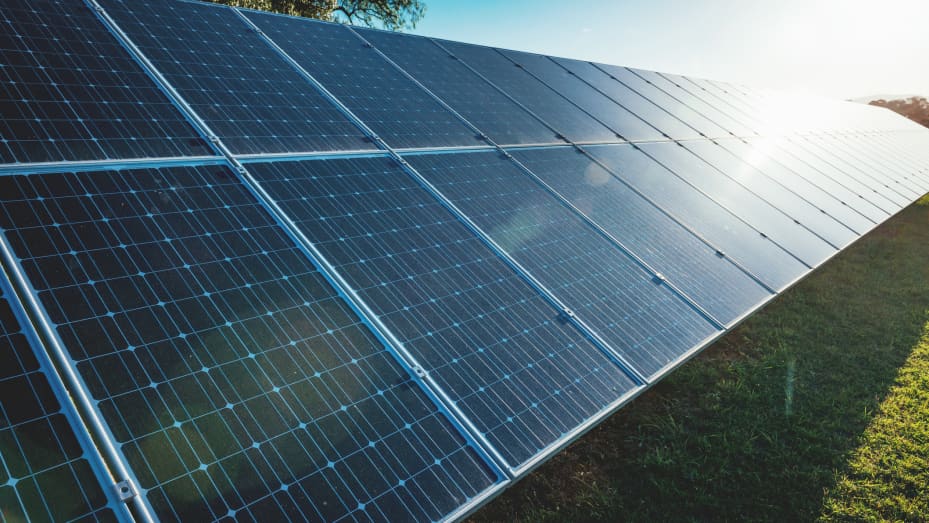NATIONALIZE THEM
P.E.I. energy minister 'disappointed' Maritime Electric limiting solar power
Company citing need to prevent ‘integrity issues’ with grid
P.E.I.'s privately-owned electrical utility has introduced a new limit on how much electricity it will allow customers to make, while the province continues to provide incentives for residents to generate their own renewable energy.
Maritime Electric has introduced a cap of 30 kilowatts of generating capacity for new and existing customers through its net metering program.
The previous limit, which is written into the province's Renewable Energy Act, had been 100 kW.
Net metering allows customers to generate their own electricity using solar panels, wind turbines or other means, and feed that into the grid in exchange for credits they can use when they draw electricity.

Maritime Electric spokeswoman Kim Griffin told CBC News the company has seen a "huge influx" of net metering applications as a result of provincial incentives for solar electricity, and said the utility is looking to prevent "integrity issues" with its electrical grid.
"It's really about keeping voltage consistent for all customers," said Griffin.
"We have over 80,000 customers so it's been about integration into the system that works and maintains quality for all, including the hundreds of solar customers."
'Disappointed and quite frustrated'
The company said most household users wouldn't require more than 30 kW capacity, and business customers can install up to 100 kW capacity if they have access to three-phase power, which is limited in the province.
P.E.I. Energy Minister Steven Myers said he's "disappointed and quite frustrated" Maritime Electric made the change without first consulting with government.
"We've introduced one of the most aggressive solar rebate programs in the whole country," Myers said.

"I believe in distributed energy and the capabilities of it. And if our network has to shift in order to accept those changes, then … we would expect somebody to reach out to us and have that conversation from Maritime Electric versus making wholesale changes and not telling us."
Myers said he only learned of the change weeks ago. Maritime Electric says it implemented the change in December.
Part of plan to reduce emissions
Maritime Electric and the province say there are now 900 Islanders taking part in net metering. The company says nearly half of those accounts started up in the past year.
P.E.I. introduced a solar electric rebate program in 2019, offering to pay 40 per cent of the costs, up to $10,000, when residents install solar photovoltaic panels at their home or business.
The province has also pledged to reduce its carbon emissions from fossil fuels as much as possible by the year 2030.
In light of the utility's move, Myers questioned whether the province has "a partner that's willing to work with us" to achieve its emissions targets.
"If we don't, we have to look at what we might need to do to fix that," he said.
Loophole in legislation
P.E.I.'s Renewable Energy Act stipulates utilities allow net metering customers to have up to 100 kW of generating capacity, but also provides for companies to refuse to sign up customers if doing so "is likely to have a serious adverse impact" on the grid or other customers.
Maritime Electric said customers who want to sign up for net metering should call the company before purchasing equipment. The company also said the 30 kW limit is per electric meter, so customers with more than a single meter can go beyond the limit.
Myers said he's considering legislative changes in response to Maritime Electric's move.
The utility admits to what it called a "miscommunication" in failing to tell government ahead of time of its plans.
Farms most likely to be affected
Green MLA Steve Howard, who owns a renewable energy company that he's placed in a blind trust, said large installations of up to 100 kW would take up to nine months of planning to get up and running.
He said he's aware of at least one company whose plans have been affected by the change, adding the move is most likely to have a negative impact on farmers, many of whom do not have access to three-phase power.
"I find that particularly problematic," Howard said of Maritime Electric's new net metering limit.

Howard pointed to a pending increase in electrical rates for farmers because the Island Regulatory and Appeals Commission has ordered Maritime Electric eliminate a tiered billing structure that provided lower electricity rates for high-consumption users.
"The solar rebate program was held up as the main way to help farmers deal with the rate shock that might come along with getting rid of the descending block rate structure," Howard said.
"This was government's way of helping farmers deal with that, and now that tool has essentially been removed because it's really only the large farms that will have the large impacts, and it's the large farms that will no longer be able to install appropriately-sized systems."






